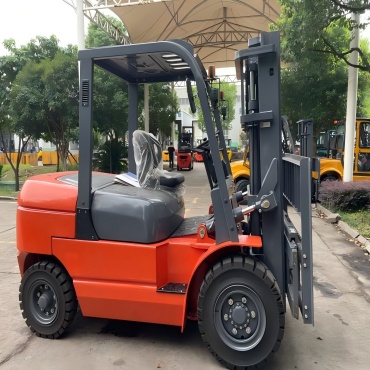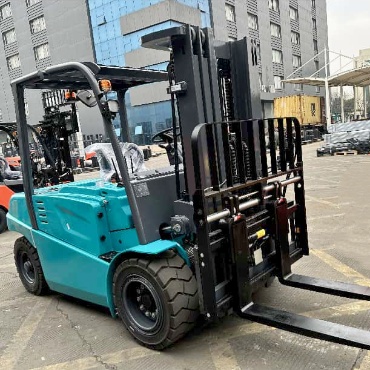- Diesel Forklift
-
- 25-30tonne Diesel Forklift 16T Forklift Truck 4.5 Ton Diesel Forklift 48 Ton Diesel Forklift 3 Ton Diesel Forklift 3.5 Ton Diesel Forklift 2.5 Ton Diesel Forklift 33 Ton Diesel Forklift 15 Ton Diesel Forklift 10 Ton Diesel Forklift 8 Ton Diesel Forklift 4 Ton Diesel Forklift 6Ton Forklift 2 Ton Diesel Forklift 1 Ton Diesel Forklift 1.8 Ton Diesel Forklift 1.5 Ton Diesel Forklift 7 ton forklift 35 ton Forklift Rough Terrain Forklift
- Electric Forklift
-
- Narrow Aisle Stand Up Counterbalance Forklift – High Efficiency Warehouse Solution 3.8ton Low Voltage Lithium Battery Forklift 12t Lithium high capacity forklift 12t large capacity electric forklift 8ton Electric Forklift 10t electric forklift truck 25ton Lithium Battery Forklift 7ton Electric Forklift 16-20t Large Capacity Lithium Battery Forklift 2 Ton Electric Forklift 1.8 Ton Electric Forklift 6 Ton Electric Forklift 1.5 Ton Electric Forklift 1.0-1.5 Ton Electric Forklift 2.5 Ton Electric Forklift 3.5 Ton Electric Forklift 4.0-4.5 Ton Electric Forklift 5 Ton Electric Forklift 3 Ton Electric Forklift 1.6-1.8Ton Three Wheel Electric Forklift 2 Ton three wheel electric forklift
- Rough Terrain Forklift
-
- 3.5t-4ton 4 wheel drive forklift 7 Ton All Rough Terrain Forklift 2-2.5T Rough Terrain Forklift Truck 4 ton off road forklift truck 3t 4 wheel drive forklift for sale 3.5t Two Wheel Drive Rough terrain forklift 3T Diesel Rough Terrain 2WD Forklift FLIFT 3.5ton all rough terrain forklift for sale 2WD 3t off Road Rough Terrain Forklift
- Electric Reach Truck & Pallet Truck / Pallet Stacker
-
- 5ton end rider electric pallet truck with customized 1.8m fork length 10ton-15ton heavy duty electric pallet truck 2.5ton all terrain electric pallet jack 1.5ton-2ton all terrain electric pallet truck with crane jib Counterbalanced Pallet Stacker 1600 lb to 2000 lb Capacity for Indoor Warehouses Heavy Duty 2T-2.5T Electric Stacker Forklift | High-Performance Stacker Lift High-Capacity 2.5t electric reach truck 1.0t -1.5t Electric Walkie Straddle Stacker 2ton Fully Electric Pallet Stacker 3 stage mast 2ton electric rough terrain pallet stacker 1.5ton off road Rough Terrain Stacker 1.8ton walkie Electric Pallet Truck Jack 1.5Ton Electric Pallet Stacker | Durable Walkie Stacker for Easy Material Handling 1200kg walking type electric pallet stacker 2ton roll and reel electric pallet truck Walkie Counterbalanced Stacker 1500–2000kg Capacity Compact Design 1ton outdoor rough terrain counterbalanced pallet stacker 3300lbs Electric off-road pallet stacker 2t Rough Terrain Pallet Truck Powered Pallet Truck with PU Wheels-2000kg Electric Pallet Jack 2t Elecric Hand Truck 1.5 Ton Electric Walkie Pallet Truck – Compact Power for Efficient Material Handling 2 Ton Reach Forklift 1.5 Ton Reach Forklift 2Ton -3Ton Electric Pallet Truck Semi-electric Pallet Stacker 1ton-1.6ton 3 Way Pallet Stacker Multi-Directional Sideloader Forklift 4 direction reach truck
- Customization Forklift
-
- 900kg CDD09B Electric Walking Type Counterweight Stacker Professional Walking Type Electric Stacker with Special Attachment 1ton Electric Outdoor Rough Terrain Telescopic Spreader Stacker 4t QDD40 Seated type Electric Tractor QDD60 Seated Type Fully Electric Tractor 3t QDD30C Electric Tractor with Turning Radius 1545mm 2t CQD20A Electric Simple Type Reach Forklift Truck 1.5t CQD15A Simple Type Electric Reach forklift Truck 5t Convertible Seated Electric Flat Truck 3t CBD30Z Electric Vehicle Transfer Truck 1.5t CDD15Y Electric Pallet Stacker (Rough Terrain) 1t CXD10-45 Electric High Lift-Order Picker 2t CQD20S-60 Four-way Walking Type Reach Forklift Truck CDD10A/15A Walking Type Fully Electric Pallet Stacker 3t QDD30A Standing Type Electric Tractor 1t CSD10 Man Mount Three-way Stacker 1.5t AGV type CDD15J-16 Electric Pallet Stacker CBD80 8t Electric Pallet Stacker 6t CBD60 Electric Pallet Stacker CBD120 1.2t Electric Pallet Stacker 2t CDD20D-30 Walking type Electric Pallet Staccker CDD08B-25 Counterweight Electric Pallet Stacker
- Forklift Attachements
-
- Waste Paper Fixture Fixed Short Arm non-sideshifting non-sideshifting Fixed Short Arm non-sideshifting Non-sideshifting Hinged Forks Caton Clamp Rotator non-Sideshifting Tire Clamps Pusher Turning Fork Clamps non-sideshifting Log Holder Sideshifting Broke Paper Clamps Sideshifting Sideshifting Single Load Stabilizer Fork Positioners Single Double Pallet Handler
Is a rough terrain forklift the same as a telehandler?
Date: 2024-11-22 View:
Is a rough terrain forklift the same as a telehandler?
No, rough terrain forklift are not the same as a telehandler.
Their differences are mainly reflected in the following four aspects:
structural characteristics, operating performance,
application scenarios and power systems.
Let's analyze them one by one:
Structural features
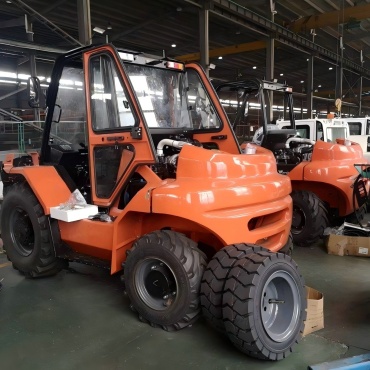
Off-road forklifts generally use all-wheel drive,
equipped with large-diameter wide-base off-road tires,
and the minimum ground clearance of the vehicle is more than 300mm,
with good passability. Its frame is mostly articulated,
with a swing angle of generally ±30°~40°, a simple steering system,
and a small turning radius.
.jpg)
Telescopic forklifts are equipped with a retractable boom,
and the fork or attachments are installed on the boom.
The body structure is relatively compact, usually with four-wheel steering function.
Its tire specifications and ground clearance
are generally smaller than those of off-road forklifts,
but the telescopic function of the boom makes its operating range wider.
Operation performance
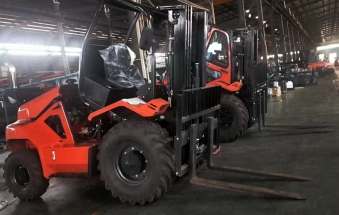
Off-road forklifts focus on loading, unloading, stacking and handling operations
in harsh terrain and complex road conditions.
They can cross obstacles on the site and can work safely and efficiently
on slopes and uneven ground.
The climbing ability is generally around 25°~30°,
and the maximum speed is 30~40km/h.
.jpg)
Telescopic arm forklifts can realize the lifting or forklifting of goods
through the telescopic and variable amplitude of the boom.
The fork can cross obstacles and pass through holes for forklifting operations,
and can stack and destacker multiple rows of goods under complex working conditions.
It is suitable for places with requirements for operating height and depth.
Application scenarios
.jpg)
Off-road forklifts are mainly used in field projects such as urban construction sites,
pipeline laying, oil field development, mountainous forest areas, and yards.
The loading and unloading of containers in the cargo yard is also used for
loading and unloading military supplies by troops during wartime.
.jpg)
Telescopic forklifts are widely used in unloading construction materials and
short-distance transportation at construction sites, material handling and site
cleaning and sorting, material handling on rough ground in industrial enterprises,
handling of hay bags in agricultural and animal husbandry pastures, feed chopping,
hay feeding, feces cleaning, etc.
They can also be used for high-altitude installation on aerial work platforms,
installation of curtain walls with glass suction cups, and other operations.
Power system
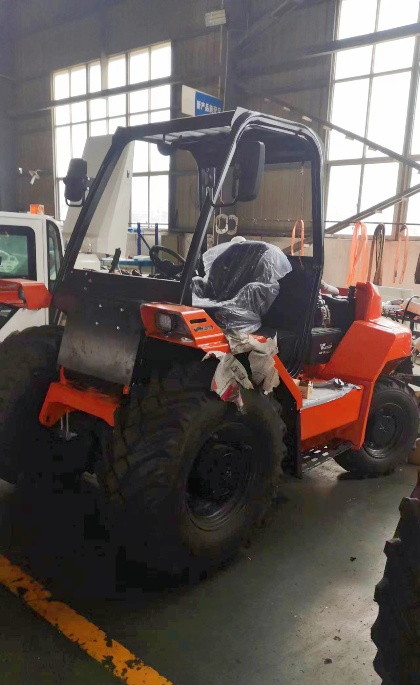
Off-road forklifts are mostly powered by internal combustion engines,
and mainly diesel engines, which are powerful, reliable, and have few failures.
The power transmission is mostly hydraulic transmission or hydrostatic transmission,
with good maneuverability and passability.
.jpg)
Telescopic forklifts usually use diesel engines as the power source,
but some telescopic forklifts also use electric drive systems,
especially some small or indoor telescopic forklifts.
Electric-driven telescopic forklifts have the advantages of
environmental protection and low noise.
FLIFT 3.5 ton 4WD off road forklift
.png)

